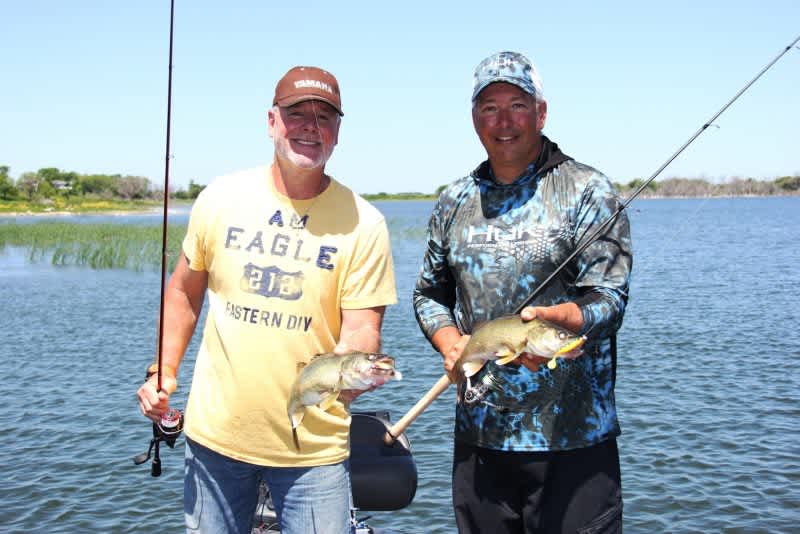Summer Walleyes in the Weeds
Bernie Barringer 07.13.16

I was expecting a crappie when my slip bobber slid under the surface, but instead a good-sized walleye came to the surface with my minnow in its mouth. Pondweed, often called cabbage by anglers in the upper Midwest, is well known for holding crappies, but walleyes were the willing biters that day. That happened often enough on a lake near my Minnesota home that I decided to explore the situation a little more closely.
There are some significant advantages to being a fisherman and a scuba diver. I decided to have a look in the tall cabbage weeds and see what was down there. I found several openings in the cabbage where the sun could get to the bottom in 5-7 feet of water – tall strands of cabbage standing like a forest around them. Around and among these stands of cabbage were plentiful bluegills, bass, crappies and walleyes – lots of walleyes, in pods of five to a dozen fish, moving along together like a wolf pack.
One more thing I found that explained it all: young-of-the-year perch – scads of them. I witnessed clouds of 2-inch perch surrounded by the predatory fish. It was a real eye-opener for me, and I’ve learned to take advantage of this situation anywhere I find it.

Finding the Best Cabbage Beds
This broadleaf cabbage, technically named clasping leaf pondweed, is a magnet for baitfish in the summer because of the cover and shade it provides. Predatory fish are well aware of its appeal to perch and minnows. The best time seems to be when the cabbage is just reaching the surface. When you see those little seed pods on top, you know the weeds are home to some fish.
Use your fishing electronics to look for stands of cabbage on shallow sloping bottoms. Back bays with large, expansive cabbage beds don’t hold as many fish as the narrow bands that follow a contour. I’ve had the best action in cabbage weed beds that are less than 20 feet wide and follow along a contour with deeper water nearby.

So how do you fish it? Well, obviously a slip bobber and a minnow works as I first discovered, but you will also be bothered by panfish and bass if you use live bait. The best lure I’ve found is a 1/8-ounce jighead with a twister tail made of scented plastic such as Gulp or Powerbait. You probably think live bait on the jig would outperform artificials, but that’s not the case. Here’s the deal with live bait: Your jig will often be hung up on a leaf and you must snap the rod with your wrist to pull it free. When you do that, you’ll lose your live bait. That’s why plastics shine in this scenario.
I like to search for openings in the cabbage beds and fish as vertically as possible. I use an electric bow-mount trolling motor to easy my way along, then drop the jig down into the openings and let it hit the bottom. It should be noted that these weeds can be found in 4 feet in dirty water, and out to about 12 feet in ultra-clear water. It’s all about sunlight penetration. It seems like the best locations are 6-8 feet in most of the water I fish in Minnesota.
After your jig hits the bottom, raise it up about a foot and swim it along through the weeds. A subtle lift-drop retrieve is all you need. Don’t move the bait too aggressively; the fish can’t catch it in the thick cover, and it just goes out of sight and out of mind too soon. Only when the jig hangs up on a cabbage stem or a leaf – and it will often – snap the rod hard to free it. You’ll be amazed how often a fish hits as soon as you let it back down. It seems as if that quick snap is a trigger that gets the fish’s attention, then the lure drops back into their strike zone. Bam, they can’t resist.

Tips for Weed Walleyes
Experiment with depths until you find the zone that holds the most fish. Walleyes like to use their superior eyesight to their advantage, and one depth will provide the most action. Sometimes walleyes will hold in the deeper areas of the weed beds, then move shallow to feed if the baitfish are shallower than they prefer to stay for long periods. Weed walleyes tend to move about in small schools, so when you catch one, quickly throw back into the same area for a chance at a second fish.
This kind of tedious fishing isn’t for everyone. You’ll be pulling up your lure often to remove a weed from the hook. This is work, plucking these fish out of the weed beds, and it requires patience and an ability to put frustration aside.
Experiment with various jig/soft plastic colors to see what works best on your lake. It’s hard to beat perch or firetiger no matter where you fish, but if the bait in the weeds happens to be minnows, shiners or another young-of-the-year fish such as bluegills, try to match the color to the primary forage. Bright colors like pink and chartreuse can work on days with heavy overcast or when the water is murky, but I find that natural colors outperform all else on most days.
Cabbage weeds aren’t just for panfish; if you find the right situation, you’ll find willing walleyes in the weeds. The fish are there for one reason – food – and that can make for some fast-paced action.

